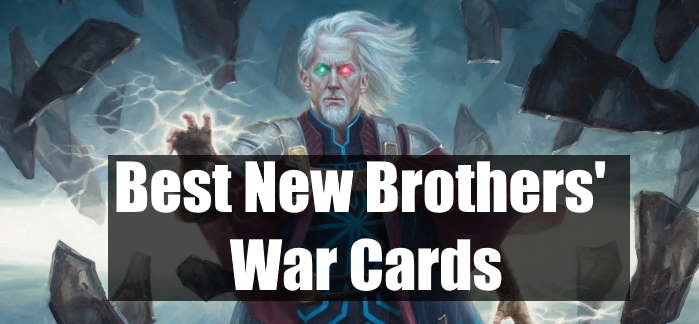This set might be taking us back to one of Magic’s oldest stories, but there are still plenty of new cards for us to experiment with. Cards from the Brothers’ War should be making their mark on tons of formats, so let’s go over what you can expect from Magic’s blast from the past!
Mechanics
Before we get into specific designs, let’s take a quick look at the mechanics you can find in The Brothers’ War. After all, you need to know how the cards work to make the most of them!
First, we have a brand new mechanic: prototype. Prototype appears on artifact creatures, and it allows you to cast them in two different ways. You can cast the card normally, or you can cast it for its prototype cost. A card’s prototype cost will be cheaper, but the creature will have a lower power and toughness. Either way, it will have the same abilities and card types.
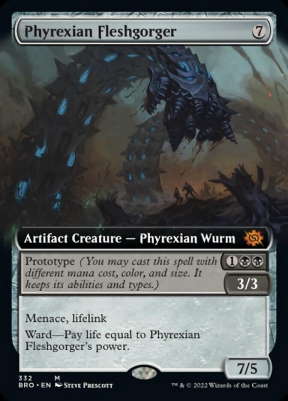
This mechanic gives players an interesting choice: do you cast a card early for its prototype cost, or hold onto it to get the bigger version? Mechanics that work in both the early and late game, such as kicker, have always been popular, so I’m excited to try this one out for myself.
Another big mechanic in this set will be powerstone tokens. We saw these already with Karn, Living Legacy, but they’ll be much more common this time around. The Brothers’ War will have plenty of artifact synergies, so these tokens fit right into that theme. It’s unfortunate that these can’t help cast any spell, but they’re useful enough that you’ll want some around.
Lastly, we have two returning mechanics: unearth and meld. We’ve actually covered both of these mechanics in previous articles, so I highly recommend reading more about them.
RELATED: MTG Unearth: How It Works and What It Does
RELATED: MTG Meld: How It Works and What It Does
Standard
Mishra, Lost to Phyrexia
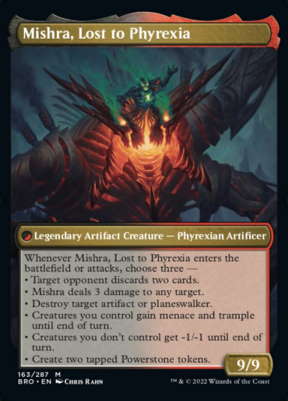
Red and black are already strong colors in Standard, and they appear in a variety of decks. While Rakdos Midrange isn’t the top deck right now, I think that Mishra, Claimed by Gix and Phyrexian Dragon Engine will be strong additions. I’m not convinced they’re strong enough to see play in Pioneer, but Mishra, Lost to Phyrexia is a hell of a payoff.
If you ever get Mishra, Lost to Phyrexia onto the battlefield, your chances of winning will skyrocket right away. It’s a huge threat that can disrupt your opponent in a ton of different ways. My only real question is how consistently you’ll get to play it, especially since its halves are lackluster alone.
Arcane Proxy
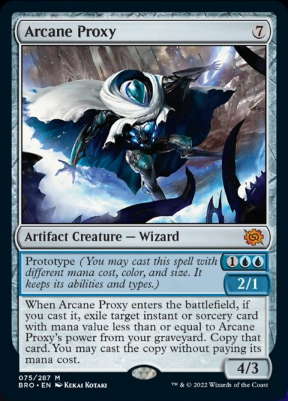
Arcane Proxy might not be as strong as Snapcaster Mage, but it’ll do a pretty reasonable impression. I imagine it’ll almost always be cast for its Prototype cost, and that option gives you a ton of value for the mana you’ll need to spend on it.
Sure, you can only get a spell that costs two or less, but that includes most of Standard’s key removal. Cut Down, Abrade, and Infernal Grasp are all one or two mana, and they already see play in the same decks as blue cards. Even if your build is heavier on blue or even mono-blue, cards like [Consider[/c] and Impulse can dig you through your deck.
Of course, Arcane Proxy has its weaknesses. Without flash, many of blue’s best spells, such as counterspells, aren’t good targets. It’s also unlikely that you’ll cast it for seven mana, and that mode is a lot less efficient. Still, any deck with blue cards and cheap spells could justify running this card, and I think its Prototype mode is strong enough to see play.
Bladecoil Serpent
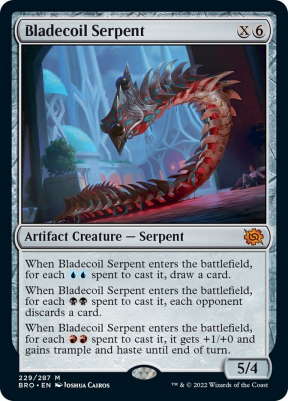
Grixis Midrange is already one of the best archetypes in Standard, and Bladecoil Serpent is another excellent payoff for running these colors. It rewards you for playing blue, black, and red, but it doesn’t require you to have any of these colors when you cast it. In fact, its flexibility is why I think it’ll be such a strong addition to the format.
Since Bladecoil Serpent is a colorless artifact, you can cast it as long as you have any six mana. However, you get effects for each pair of colored mana you use to pay for it. You can also get the same effect more than once, such as drawing multiple cards if you pay with lots of blue mana. This means you can choose what effect Bladecoil Serpent will have based on what you need. This is especially powerful if your deck has lots of dual lands.
RELATED: MTG Dual Lands: All Your Questions Answered
Large creatures that can give you card advantage are fantastic. If you’re behind, playing a 5/4 and forcing your opponent to discard two cards could stabilize you instantly. When the
Gix, Yawgmoth Praetor
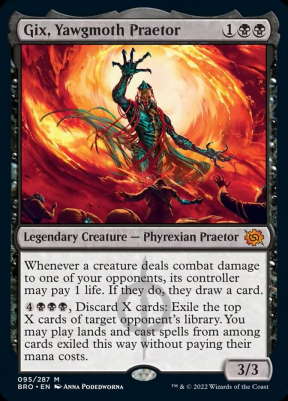
Finally, we have one more key character from the Brothers’ War story: Gix, Yawgmoth Praetor. I’ve already mentioned that black is one of the best colors in Standard right now, and Gix fits perfectly with the color’s other key cards.
Resilient threats like Tenacious Underdog ensure that you can always threaten drawing an extra card. Evolved Sleeper is another cheap creature that can trigger Gix in the early game.
Of course, Sheoldred, the Apocalypse is one of black’s best Standard cards, and it synergizes effortlessly with Gix. She gains you two life whenever you draw a card, essentially negating the life loss from Gix’s effect. Graveyard Trespasser is another black staple that rewards you for attacking and gains you life. Of course, paying one life for a card is still worth it, but incidentally gaining that life back is huge.
Gix, Yawgmoth Praetor also gives you inevitability. If you’re drawing too many lands in the late game, you can ditch them to his second ability and start casting spells for free. Unless you completely whiff on this effect, or if you’re already far behind, it’s hard to imagine losing if you get to activate this ability. Gix just provides a ton of advantage throughout the game, and he’ll force you opponents into some difficult decisions.
Pioneer
Siege Veteran
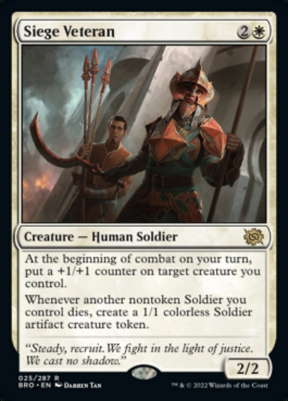
Mono-White Humans is already a powerful archetype in Pioneer, and many of its best cards are soldiers. Siege Veteran not only rewards you for playing this tribe, but it also has the same effect as one of the deck’s best cards: Luminarch Aspirant. Pumping out +1/+1 counters every turn for free is fantastic, so playing Luminarch Aspirant into Siege Veteran will be back-breaking for your opponents.
On top of this powerful effect, Siege Veteran creates 1/1s whenever your nontoken soldiers die. As a result, your
Whether this card slots into existing decks or forms new strategies with a bigger focus on soldiers, Siege Veteran
Titania, Gaea Incarnate
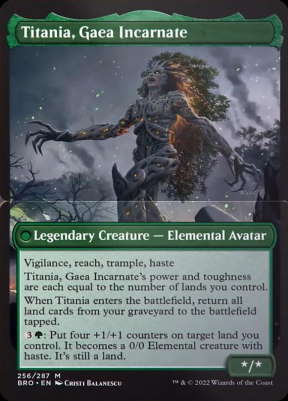
We’ve already seen the strength of graveyard synergies in Pioneer, both with Rakdos Midrange and Abzan Greasefang. You can already fill your graveyard with ease, and Titania, Gaea Incarnate is a cheap but effective payoff. Not only is it a great win condition on its own, but each of its halves are solid on their own.
Titania, Voice of Gaia is a reasonable defensive creature that can gain you extra life. Argoth, Sanctum of Nature, though, seems like a great addition to graveyard decks. Whenever your lands can give you spell-like effects, it’s worth taking a look at them.
In Argoth’s case, it gives you
Commander
Portal to Phyrexia
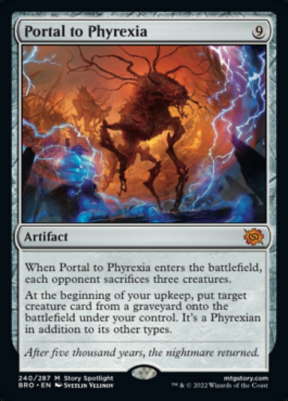
Portal to Phyrexia is an incredible card. Not only is it a one-sided
Nine mana is a ton to ask for, especially for a card that doesn’t win the game on the spot. Portal to Phyrexia at least affects the
If your deck can generate lots of mana, or if it can cheat this card into play, then Portal to Phyrexia will be awesome. Otherwise, you’re taking a bit of a risk with such an expensive card.
Tocasia’s Welcome
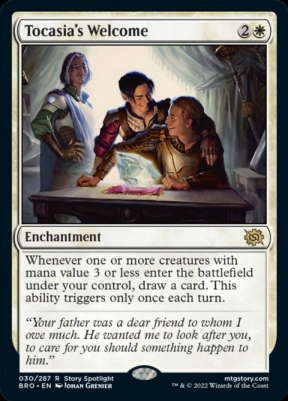
WOTC has been giving white lots of different options for card advantage in recent years, and Tocasia’s Welcome is a welcome addition to that lineup. Most white decks are already running small value creatures, so it won’t be hard to trigger this card’s ability. Drawing a card is a nice reward for following your deck’s strategy, though it’s unfortunate that you can only get one card per turn.
Token decks will be able to make the most out of Tocasia’s Welcome. If you’re able to create tokens on other players’ turns, you’ll be able to get more than one card each turn cycle. Cards like Trostani, Selesnya’s Voice and Thraben Doomsayer give you a repeatable way to make tokens, but there are also one-shot instants that create tokens.
No matter how you’re using it, Tocasia’s Welcome will give some much needed card draw to creature-based white decks.
Visions of Phyrexia
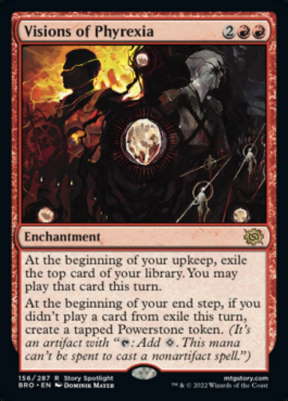
Much like white, red has struggled in EDH due to being more focused on aggression than value. In recent years, however, mechanics like impulsive draw and treasure have given the color lots of new tools to catch up. Visions of Phyrexia is yet another red card that’s built for Commander, and it’s an interesting take on red’s usual forms of card advantage.
RELATED: The Best Precon Commander Decks
At a baseline, Visions of Phyrexia is just another Outpost Siege effect. Getting an extra card turn after turn is nice, but impulsive draw effects have their downsides. These cards only let you play what you exile for a certain period of time, so you might not always get the full value from them. If you exile a card you can’t cast, or don’t want to cast, it can feel like you’re wasting resources.
When you play Visions of Phyrexia, though, you’ll always get something. If you don’t play a card from exile, you get a Powerstone token. This means that you can choose between ramp and cards every turn, so you can always get the resources you need. In fact, artifact-heavy decks might just want to get a steady stream of Powerstones unless they exile something incredible.
Visions of Phyrexia addresses the biggest weakness of impulsive draw, and that makes it a great value engine for red decks.
End Step
With that, we’ve gone over all the best cards you can look forward to in The Brothers’ War! Whether you’re excited for these or have your own brews in mind, it should be an exciting set for fans of many formats!
